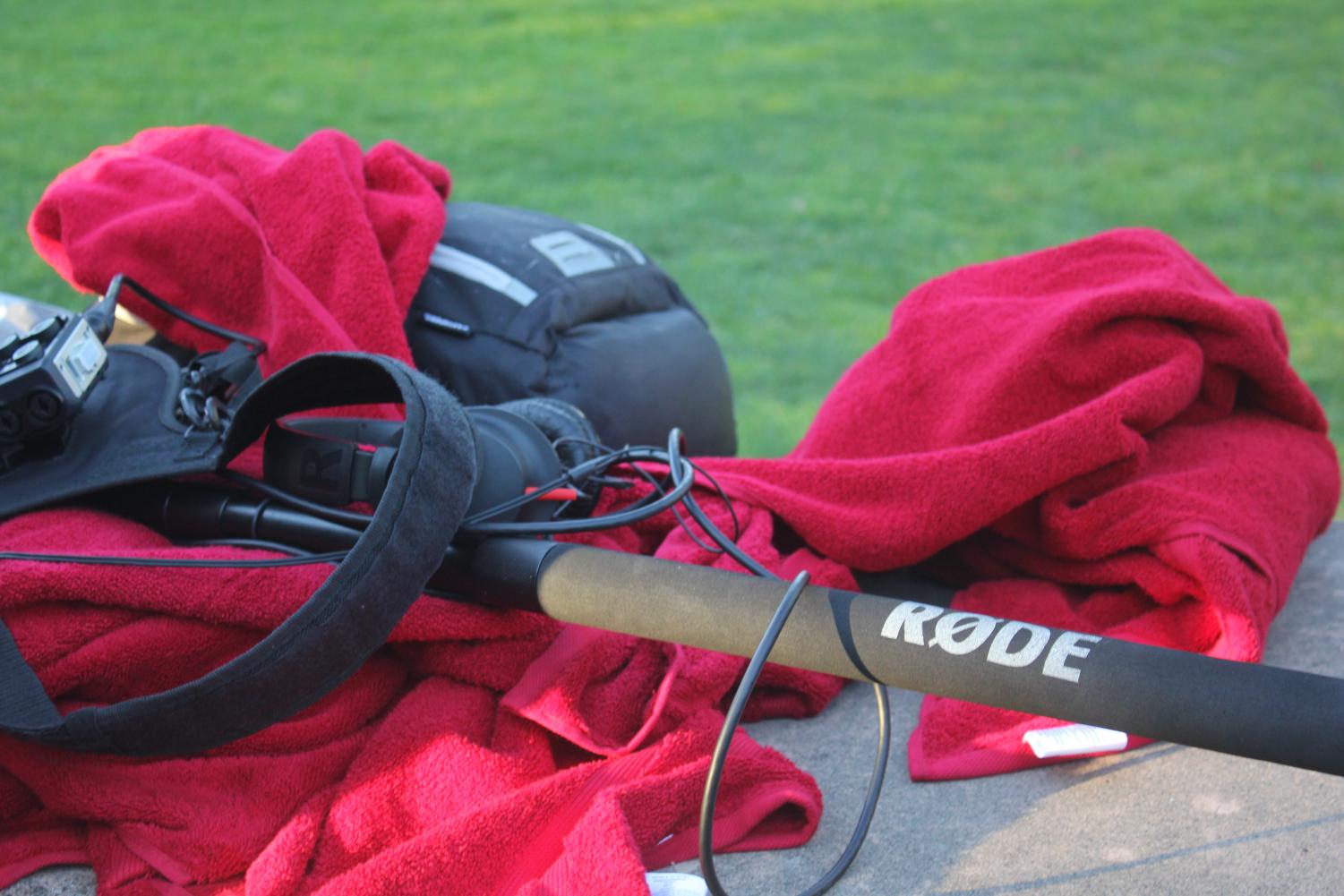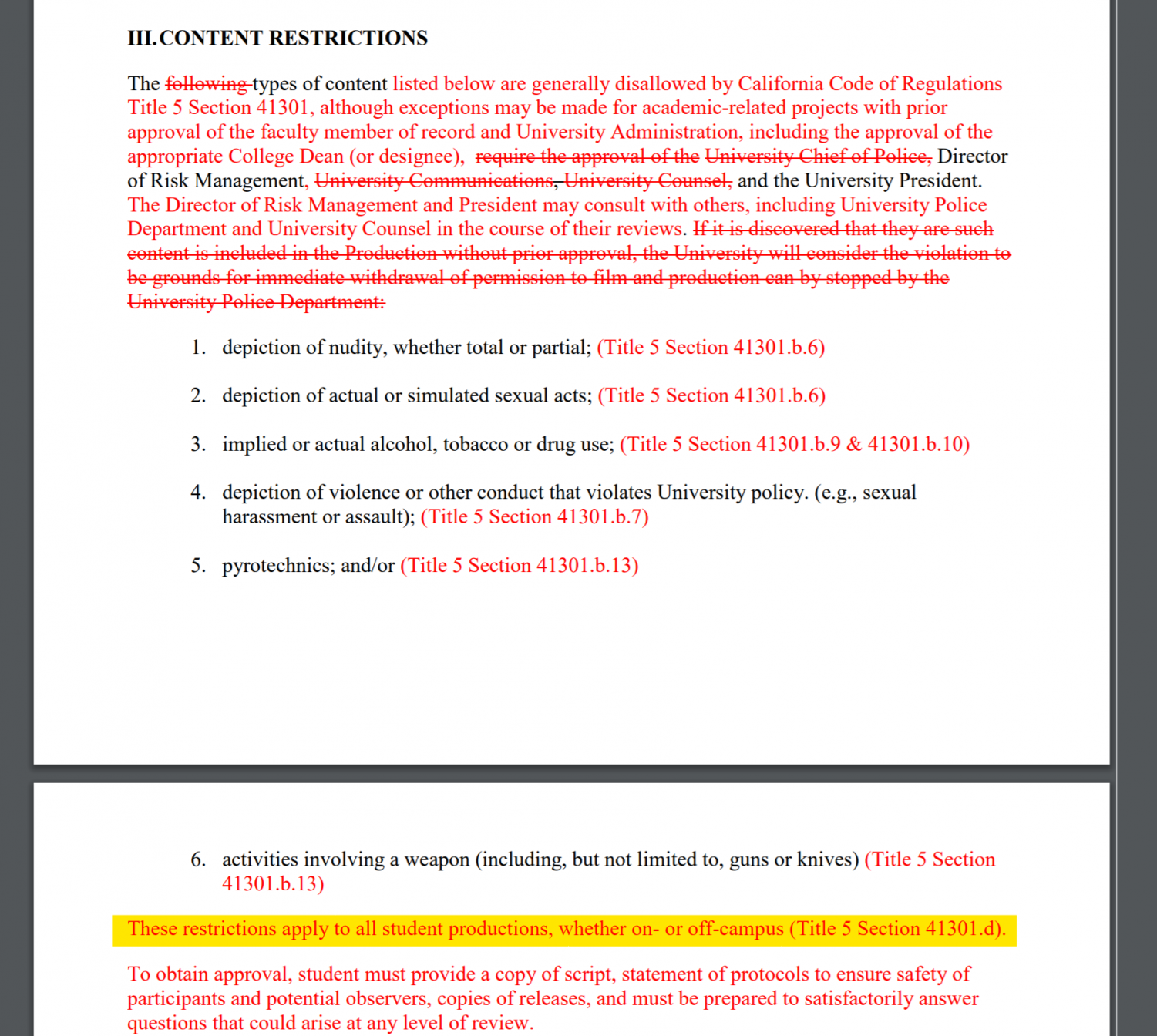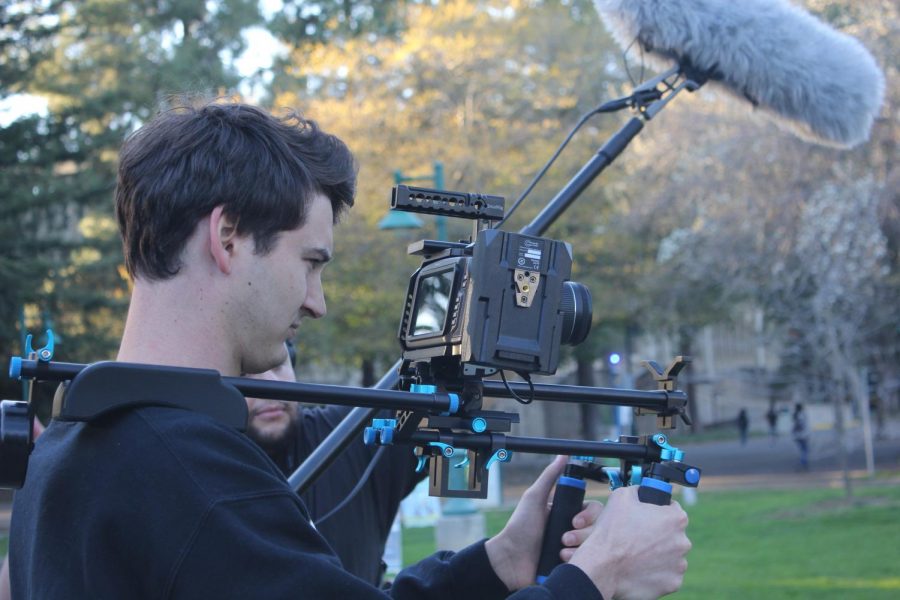‘What does the campus expect us to make?’: Sac State students, faculty express concerns over proposed visual content restrictions
Drafted policy requires pre-approval of some student, third-party content
Sac State film production major Dylan Peshek records his peer’s senior project at the Library Quad while his friend Matthew Behnam operates the boom microphone on Monday, Feb. 24. Sac State already claims authority to halt any filming that it finds interfering with normal campus operations according to recently implemented policy.
Sacramento State film student Heather Uroff has been working on her film “Reflections” since she wrote the script last spring.
It is implied in “Reflections” that the main character was sexually assaulted, without actually depicting the assault, Uroff said.
But a drafted Sac State policy proposing new restrictions on student media — including multiple layers of prior approval, restrictions on content that can be filmed on or off campus, and punishments for students who violate content restrictions — could prevent students like Uroff from creating that type of content.
“What does the campus expect us to make if we can’t make films that are about our own experiences, or things that we’ve seen, or society?” Uroff said. “Do they want us to make Hollywood films about a princess and a frog with a happy ending? I don’t know.”
Restricted content in the “Visual and Sound Productions by Students” drafted policy includes:
- Simulated or actual sexual acts
- Total or partial nudity
- Implied alcohol, tobacco or drug use
- Depictions of violence
- Pyrotechnics
- Activities involving a weapon
- Other violations of university policy
Students recording restricted content would be required to get prior approval from an appropriate college dean, the director of risk management and the university president.
Kathy Kasic is one of Uroff’s film professors.
“If she can’t make a comment on sexual assault as a student who’s learning the craft of filmmaking, learning to create stories about aspects that really matter in our society, then her learning is greatly disabled if she’s limited by what content she can create,” Kasic said.
Another student of Kasic’s, film production major Dylan Peshek, wrote and directed the film “Disappear.” The climax of the film features a girl saving her best friend from a sex trafficker using a tazer.
“Violence is a powerful medium in order to convey strong emotions from characters and have characters show change,” Peshek said.
Peshek said if a week is lost in the prior-approval process, student films may not be finished in time for the showcase during finals week.
“It could delay your production to where you don’t get it done in time in order to show it in the showcase,” Peshek said. “And then everyone’s hard work is for nothing.”
Kasic said she has students film during class and sometimes teaches students how to film in sunlight. Both of these could violate the policy’s clause which prohibits filming from interfering with the normal operations of Sac State.
Kasic added that “a number of things in the policy” go against what the film department at Sac State tries to accomplish.
Sac State’s current visual and sound production policy was implemented in December 2017.
Ántonia Peigahi, Sac State director of policy and records management, said the current policy does not apply to people taking videos on social media, students producing media for academic reasons or journalists.
In 2018, Sac State announced it was revising the policy that had been implemented due to concerns about its constitutionality and the restrictions it would place on student media. There were also no consequences for violators listed on that version of the policy.
RELATED: Sac State media policy to be revised following concerns it is unconstitutional
Another concern was the vagueness of the policy’s language. A senior legal fellow with the Student Press Law Center said the outlined rules could apply to anyone wanting to create visual or audio content on campus, including students using their smartphones.
A Sac State public information officer disagreed with this at the time, and said that the policy would not apply to people shooting video on social media, students producing media for academic reasons or journalists.
However, the senior legal fellow said the people working at Sac State giving these verbal reassurances would not always work there, and the text of the policy could be interpreted that way, according to whoever is in a position of power at any given moment.
Story continues below photo.

Sac State film production major Dylan Peshek and his friend Matthew Behnam’s equipment on Monday, Feb. 24.
A student found to be in violation of the restrictions of the current proposed policy could have all production halted by their professor, the dean of students or the Sac State Police Department. Violators would also be subject to disciplinary action, including, but not limited to, expulsion, suspension, or probation.
“Students in violation of this policy may be subject to a Student Conduct Code review and possibly subject to disciplinary action including, but not limited to, expulsion, suspension, or probation,” the proposed policy reads.
Peigahi said the policy changes were drafted before she took office. She said the goal of the proposed policy changes is to clarify what rules and rights apply to student films versus non-affiliated films.
Faculty members in the College of the Arts & Letters have also expressed concerns about the current drafted policy.
“The journalism department and the film department are paying real close attention to this policy because it really goes to the heart of what we do and what we’re training our students to do,” journalism professor Phillip Reese said.
Reese said that journalism students are taught to cover newsworthy events on campus, which could include violations of the content restrictions such as fights. He said the policy goes beyond journalism and due to its vagueness, could apply to students filming things for social media.
“Students should read this policy because it really does apply to what they can put on social media,” Reese said. “If they’re filming things that are happening, I think they’re protected by the Constitution.”
Mike Hiestand, Senior Legal Counsel at the Student Press Law Center, laughed at the clause applying the policy to students using personal or professional devices to post on monetized social media.
“This is a public campus. This is public space. A public university is kind of the quintessential marketplace of ideas,” Hiestand said. “You don’t tell students in 2020 that they can’t use their smartphone to record and share the world around them. It doesn’t work that way.”
Dean of the College of Arts & Letters Sheree Meyer said the current policy was made in response to two filming incidents on campus.
In one of those instances, an external entity filmed on campus without Sac State’s knowledge and in the other, a student filmed a scene that appeared to contain firearms.
Meyer was previously Dean of Undergraduate Studies and at that time, was part of a committee that developed the media policy. She said the goal is not censorship but to ensure filmmakers alert campus officials before production.
“Art of any kind can be controversial, so as we minimize risk, we don’t want to harm the creativity and the artistic expression of our students,” Meyer said.
Meyer said she is not involved with the drafted policy and has not been contacted personally about the media policy since summer 2018.
“The film students film at a variety of locations, so what that means for them isn’t clear to me from that document,” Meyer said.
Peigahi said the drafted policy does not apply to locations off campus which are not owned, leased and/or controlled by Sac State. However, the drafted policy reads, “These restrictions apply to all student productions, whether on or off campus.”
Story continues below screenshot.

“My general view of the policies are that they have a foul smell to them,” said Professor Mark Ludwig, a Sac State journalism professor, who has been on the Faculty Senate since 2014.
According to the Faculty Senate Executive Committee’s Feb. 4 meeting minutes, the drafted policies were passed from the Executive Committee to the Curriculum Policies Committee. The Curriculum Policies Committee has until April 10 to provide recommendations to Faculty Senate Chair Adam Rechs.
A separate policy was written up for third parties including external production, commercial and news entities.
Commercial productions containing restricted content require prior approval from Sac State Police, Risk Management, University Counsel and President Robert Nelsen.
Both policies originated out of the Division of the President in fall 2018, Sac State Public Information Officer Anita Fitzhugh confirmed.
Kasic, Reese and Meyer all said they trust the faculty senate will discuss the proposed policies thoroughly.
“I trust the faculty senate to ask good questions and to present it to faculty in a way that will get the feedback that they need,” Meyer said.
Peigahi said the policies are now being reviewed by the Faculty Senate Curriculum Policies Committee, and concerns about First Amendment violations will be addressed in the Faculty Senate.
“I’m sure as the committee looks at it, those things will get hashed out,” Peigahi said.
Your donation will support the student journalists of Sacramento State University. Your contribution will allow us to purchase equipment and cover our annual website hosting costs.

 |  |






















































































































Melissa • Mar 10, 2020 at 2:12 pm
This proposed policy is not different from other speech codes. Remember, “words are violence.”
Is it any surprise that it’s all coming back to bite milder speech?
You reap what you sow.
Anonymous • Mar 4, 2020 at 2:01 am
This is a very lengthy and passionate article, but I had to stop a few paragraphs in. University is about teaching skills for employability. Your passion project can wait. Employers will impose restrictions on you – restrictions including the one’s now mandated by the campus. Nothing is stopping you from pursuing further projects on your own time, and it’s actually necessary if you’re trying to build a portfolio worth a damn.
Kelsey • Mar 3, 2020 at 11:20 pm
As a photo major, this concerns me greatly. There is a lot of art that deals with violence or sexual themes (i think one could argue most art or at least most art of certain time frames). How are we supposed to grown and learn as artists if we cannot deal with these themes in our own art?
Kyleigh Johnson • Mar 3, 2020 at 11:12 pm
As a graduate from sac state’s art dept, this makes me deeply uncomfortable. When we start restricting what students are able to create, and therefore restrict what it is they are able to say, when do we draw the line? How long before these policies spread from film to visual arts to performing arts to literature, in the name of “the greater good”? Freedom of speech exists for a reason, and to me, this cuts just too close to censorship. I understand (supposedly) these rules are to protect the school and students, but there’s got to be a better way.
Jeremiah Ramirez • Mar 3, 2020 at 4:43 pm
“Both policies originated out of the Division of the President..”
With all the favorable sentiment President Nelsen enjoys, why is his office pursuing such a misguided and unconstitutional policy that undermines academic learning?
The policy clearly exceeds reasonable risk planning. It’s very disappointing and should result in more scrutiny to his office.